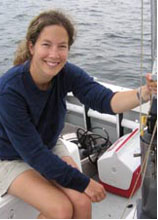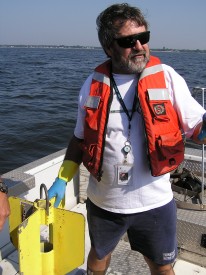Coupling sediment Fe(II) oxidation with denitrification and DNRA
Project Title: Coupling sediment Fe(II) oxidation with denitrification and DNRA
Date: 2019-2020
Principal Investigator(s): Claudia Mazur, Robinson Fulweiler
Affiliations: Boston University
Summary: Nitrogen is an essential nutrient for primary productivity in coastal systems, yet excess nitrogen loading from human activities such as fertilizer runoff and wastewater treatment discharge can lead to a series of negative consequences. These consequences include harmful algal blooms, low oxygen conditions and decreased biodiversity. To reduce these impacts, we aim to understand the environmental conditions that drive the pathways of nitrogen retention (dissimilatory nitrate reduction to ammonium or DNRA) and removal (denitrification) in estuaries. One environmental condition influencing these processes may be the presence of iron (Fe). The purpose of our research is to determine how iron oxidation rates alter the sediment microbial community composition and subsequently rates of nitrogen retention and removal costal sediments. We will collect sediment and porewater samples along a gradient of high to low concentrations of iron from the subterranean groundwater discharge located at the head Waquoit Bay. We will use these samples to (1) quantify seasonal rates of sediment iron oxidation, denitrification and DNRA, (2) determine how concentrations of iron and nitrate alter rates of denitrification and DNRA and (3) characterize the potentially active sediment microbial community. By understanding the factors that influence processes such as denitrification and DNRA, we can better predict the fate of nutrients and productivity in coastal sediments.
Quantifying the Impact of Low Oxygen Conditions on Sediment Methane Fluxes in Waquoit Bay
Lead Investigator: Wally Fulweiler, Boston University Marine Program
Funding Source: MIT-Seagrant
 The negative consequences of excess nutrient loading alter estuarine sediment nutrient cycling in general and the production of methane in particular. On a per molecule basis, the impact of methane on climate is over 20 times greater than carbon dioxide (over a 100 year period). And even though estuaries make up a small portion of the total global ocean area they contribute about 10% of the total ocean methane emissions. Thus, quantifying how the production of methane in estuaries changes seasonally and spatially is an important step in our understanding of coastal systems and future climate. The purpose of this ongoing research is to quantify sediment methane production in Waquoit Bay, MA and to determine how low oxygen conditions alter these rates. To do this we collect sediment cores at four sites exposed to varying oxygen conditions in the Waquoit Bay system and measure methane fluxes across the sediment-water interface. Additionally, we will conduct experimental manipulations where we alter the oxygen conditions in the overlying water to see how this impacts methane fluxes. For more information please go to: www.fulweilerlab.com and follow us @Fulweilerlab.
The negative consequences of excess nutrient loading alter estuarine sediment nutrient cycling in general and the production of methane in particular. On a per molecule basis, the impact of methane on climate is over 20 times greater than carbon dioxide (over a 100 year period). And even though estuaries make up a small portion of the total global ocean area they contribute about 10% of the total ocean methane emissions. Thus, quantifying how the production of methane in estuaries changes seasonally and spatially is an important step in our understanding of coastal systems and future climate. The purpose of this ongoing research is to quantify sediment methane production in Waquoit Bay, MA and to determine how low oxygen conditions alter these rates. To do this we collect sediment cores at four sites exposed to varying oxygen conditions in the Waquoit Bay system and measure methane fluxes across the sediment-water interface. Additionally, we will conduct experimental manipulations where we alter the oxygen conditions in the overlying water to see how this impacts methane fluxes. For more information please go to: www.fulweilerlab.com and follow us @Fulweilerlab.
Assessing the Impact of Hypoxia/Anoxia on Sediment Denitrification and the Production of Nitrous Oxide in Waquoit Bay
 PI: Wally Fulweiler, Boston University Marine Program
PI: Wally Fulweiler, Boston University Marine Program
Funding:WHOI-Seagrant
Using Molybdenum Concentration in Estuarine Sediments as a Proxy for Hypoxia Occurrence and Frequency

PI: Warren Boothman (EPA)
Description: With the assistance of the Waquoit Bay Reserve, staff from the Atlantic Ecology Division of the U.S. Environmental Protection Agency’s National Health and Environmental Effects Research Laboratory are examining the relationship between the frequency of hypoxia (low dissolved oxygen) in marine waters and accumulation of molybdenum (Mo) in sediments underlying those waters. Previous research in Narragansett Bay (RI) has shown that Mo accumulates in sediments when the water above becomes low in oxygen and revealed a linear relationship between the total period of hypoxia and concentration of Mo in surface sediment. To test whether the relationship is valid over a wider spatial scale, the same analyses are being done at monitoring sites within Waquoit Bay that have more than a decade of water quality data. Research chemist Warren Boothman (EPA) and Chris Weidman, Research Coordinator at the Waquoit Bay NERR, collected 12 sediment cores from 4 sites in May that will be sliced into 1-cm thick sections and analyzed for Mo. Results of the chemical analyses will be combined with historical records of dissolved oxygen to determine whether the Mo-DO relationship found in RI is also valid in coastal water bodies in MA and presumably elsewhere. In addition to examining the Mo-DO relationship in recent years, vertical profiles of Mo in the cores could develop a historical perspective on the frequency of hypoxia in Waquoit Bay.
For more information on this research, contact Warren Boothman (401-782-3161, boothman.warren@epa.gov).
Collaborative Research


